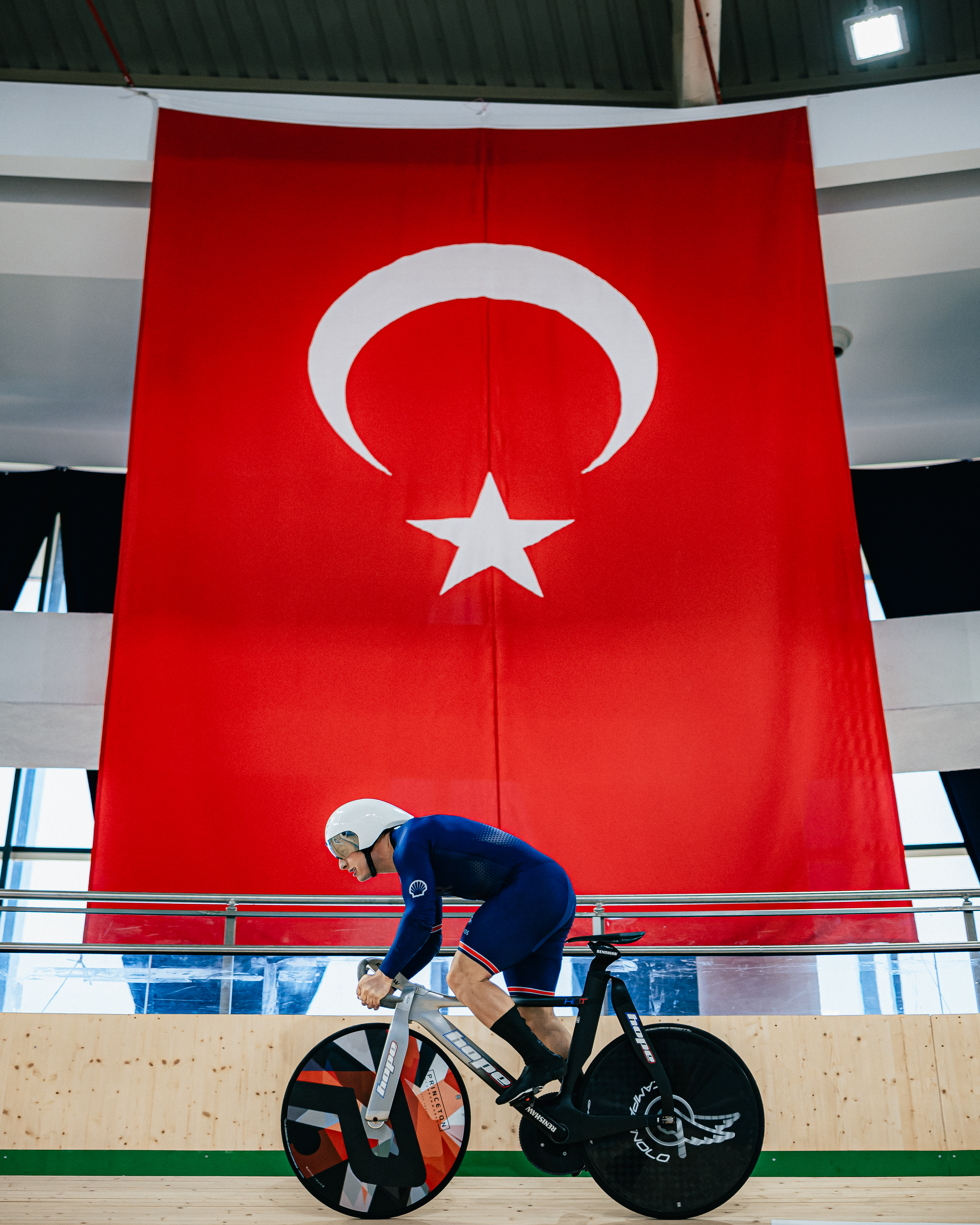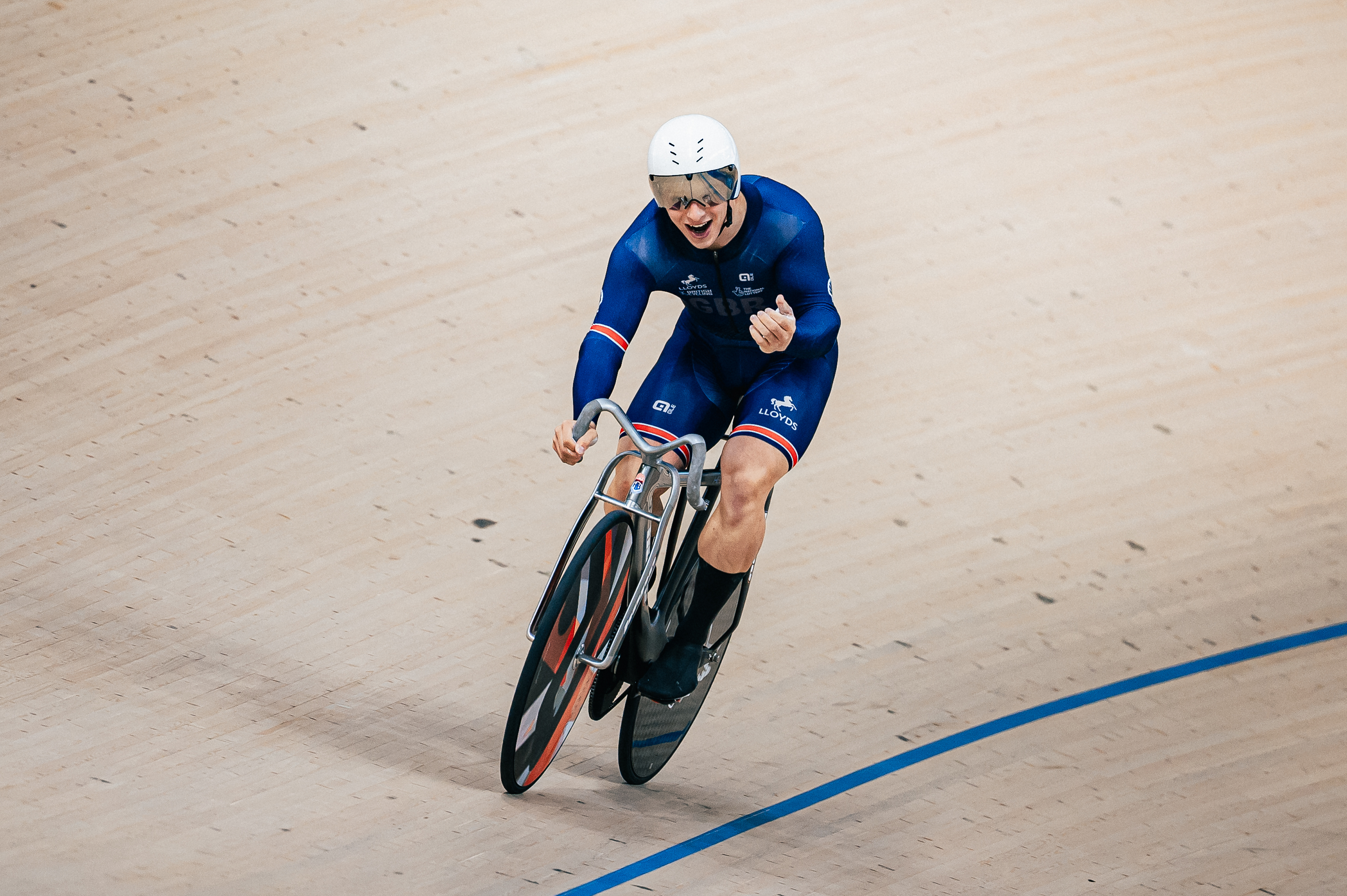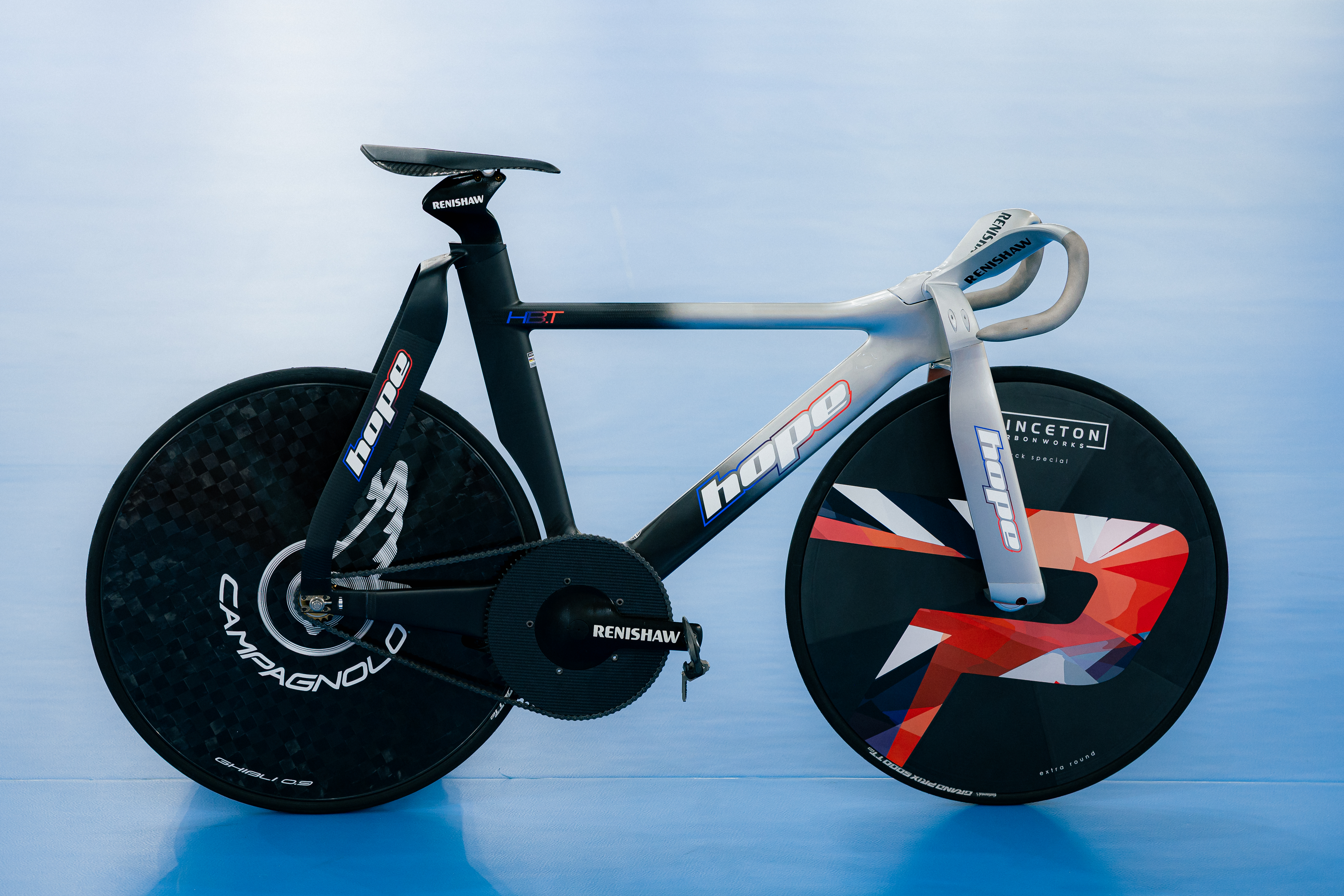This feature originally appeared in Cycling Weekly magazine on 11 September 2025. Subscribe now and never miss an issue.
Matthew Richardson was the last person in the velodrome to realise he had broken a world record. Barrelling at 80kph (50mph), dizzy-eyed, and with his legs still spinning wildly, the small timing board at the top of the banking was a haze of red and blue. The roars from his skeleton support crew, had he been able to hear them, might have given him a hint of his triumph. But Richardson had gone deep, and his bike wasn’t slowing down. “The wind was travelling past my head so fast it blurred a lot of the cheering out,” he remembers. “It wasn’t until probably half a lap later that I actually saw the number 8.9 that I realised I’d done it.”
Never before had a person clocked below the nine-second barrier for the flying 200m. In two attempts, inside Konya’s velodrome in Turkey, the Brit managed it twice.
On 14 August he went 8.941 seconds, before returning the following day and going even quicker, settling the record at 8.857 seconds. “It’s the fastest time trial that there is in track cycling,” says Richardson of the event. “It’s a raw measure, basically, of who is the best.”
As such, like the foremost 100m sprinter in athletics, he now lays claim to being the fastest cyclist in the world. It’s a title that was earned in a matter of seconds, but one that took months of training, a crack team of engineers, and an unwavering will to find speed. Here’s how Richardson did it.
(Image credit: Alex Whitehead/SWpix)
It was mid-March, five months before the record attempt, when the idea first truly took hold. The UCI Nations Cup round in Konya, the first international meet to be held at Turkey’s new velodrome, was Richardson’s first major event with GB since swapping nationality from Australia. It was expected to be a cakewalk for the sprinter, and it was, to an extent: he came away with two gold medals, but the flying 200m qualifier for the match sprint left a sour taste in his mouth. The timing board flashed up after his effort with a new world record. A UCI review of the footage then found the Brit had strayed off the track, beneath the blue band, and his time was voided.
Richardson had known disappointment before. At last year’s Paris Olympics, he held the record for a matter of minutes, before Dutchman Harrie Lavreysen took it off him.
He left the Nations Cup event in Konya in search of redemption. “We realised how quick that track was,” he says. The whole world did: China’s Yuan Liying broke the women’s benchmark on the same, fresh boards the day before Richardson’s botched effort. The Brit scrapped a loose plan he had harboured for years to go record-hunting at altitude in Bolivia or Mexico. Konya, he decided, would do just fine.
Why Konya velodrome?

(Image credit: Alex Whitehead/SWpix)
After Richardson’s initial, disqualified, 200m world record in Konya in March, he decided to return to the same velodrome for an official attempt.
Located on the outskirts of the Turkish city, the track was opened in 2022, and is pitched at 1,200m above sea level; its altitude lowering the air density, which reduces aerodynamic drag. It is eight metres wide, one metre wider than standard tracks. It is also slightly steeper, at 45.5°, compared with London’s Lee Valley Velodrome, for example, at 42°. “For a flying effort, it’s pretty optimal,” Richardson says.
The only downside is it can be tough to handle in the corners. “There’s a tiny little section [out of the bends], for about five or 10 metres maybe, where it still kind of turns, but not as much as the corner,” the sprinter explains. “You’re trying to turn the rest of the corner, but the corner’s not as sharp as it was anymore, so you end up just steering yourself off the track.” Misjudging this is how Richardson ended up riding below the wooden boards in March.
The August trip would last five days. Organised by British Cycling as a behind-closed-doors event, Richardson would have two days to acclimatise, and two to chase the record, before his flight home to Manchester. His first attempt was scheduled for Thursday afternoon at 4pm, a time he chose, but not for any scientific reason. “I just didn’t want to have to get up too early,” he says.
As it so happened, 4pm coincided with the day’s warmest temperature – 36°C – bringing favourable atmospheric conditions. When I ask him to go into more depth about the air density, he refuses. It’s for the same reason he won’t reveal the gearing he used on his bike, likely a little over 130 inches. “I don’t want people to map out exactly what I did,” he says. There will be no copycat attempts of his record. The information remains classified to his small crew inside the velodrome.
Richardson’s warm-up began with a turbo trainer spin at 10am. He then necked an oat smoothie for lunch, and returned to the velodrome around 1pm. “It was a pretty chill day knowing all I have to accomplish is one flying 200,” he says.
Nevertheless, the pressure was on. For months, he had dedicated training sessions to practising the effort, improving his top speed and peak power. Short and muscly in stature, shaped like a bullet, he had also changed his ‘wind-up strategy’, working to stay seated for improved aerodynamics, rather than rising out of the saddle.
For the day, his father, Nigel, flew in specially from Perth, Australia, where the family relocated when Matthew was nine years old. “It was important to me that he was there,” the sprinter says. “He was the one that brought me to the velodrome back in Perth many, many years ago now. He was the one that kind of introduced me to track cycling.”
Flying 200m world record progression in last decade
6 December 2013: 9.347 seconds – François Pervis (France)
6 September 2019: 9.1 seconds – Nicholas Paul (Trinidad and Tobago)
7 August 2024: 9.091 seconds – Matthew Richardson (Australia)
7 August 2024: 9.088 seconds – Harrie Lavreysen (Netherlands)
14 August 2025: 8.941 seconds – Matthew Richardson (Great Britain)
15 August 2025: 8.857 seconds – Matthew Richardson (Great Britain)
Current women’s world record: 9.976 seconds – Yuan Liying (China). 15 March 2025.
Unlike on race days, there was near silence in the velodrome in the moments before Richardson’s first attempt. It may have seemed eerie, but it didn’t bother him. “I’m always someone who can switch it on, no matter what the occasion; if there’s people in the crowd or there isn’t,” he says.
To help stir the airflow, a motorbike rider took to the boards and ripped around the track at speed. The clock then ticked closer to 4pm, and the time came for Richardson to start winding up his effort. His final exchange of words was with British Cycling coach Andy Pink, the man tasked with giving the sprinter a mammoth, both-feet-off-the-floor push. “I asked if he was ready,” Richardson recalls. “He asked if I was ready, and we both said, ‘Yep.’ Then there we go. He pushes me off.”
Richardson trudged to the top of the banking, and began circling the track slowly, like a raptor hovering over its prey. After three laps building momentum, as per UCI rules, he swooped at full tilt down to the black line, and a bell sounded. The whole sequence lasted less than a minute and a half. After he crossed the finish line, it took another half second before his time flashed up on the board: 8.941 seconds. He had done it: the nine-second barrier had at last been broken. A wobbly Instagram Live feed caught the aftermath of the attempt.
The camera zoomed in on a panting Richardson as he stepped off his bike and keeled over. “The pain in my legs was actually OK,” he recalls, “but the vomiting definitely came. I was like, ‘Oh, I need a bag’ – a classic Richo move – and sure enough a bag came very quickly, and I delivered by filling it all the way up.” The live feed ended abruptly as the scene began. “The substance that came out of my body wasn’t pleasant. I think it was quite black, from memory, which didn’t make me feel super-good. It was a bit of a nightmare,” Richardson laughs.

(Image credit: Alex Whitehead/SWpix)
With no fans in the stands, the celebrations were intimate inside the track centre. Richardson first wrapped his arms around his partner, GB sprinter Emma Finucane, before receiving a warm pat on the back from his father. In the front of his mind, though, his brain was already lining up another stab at the record.
“I needed to get a safe attempt in,” he says. “Given what happened at the Nations Cup earlier in the year, I just wanted to get the first ride under my belt.” That ride, he felt, was lacking in execution. “I rode a lot of it outside the sprint lane,” he explains – that’s to say above not only the black line, but the red one, too. Fearful of steering beneath the track again and colliding with one of the foam pads, Richardson’s cautiousness likely added a few precious metres onto the distance. “I knew there was more time on the table,” he says. He returned the next day ready to go again. “I just let all hell loose.”
There was no live feed of Richardson’s Friday effort, so only he and those inside the velodrome know how well he rode it. Still, the extra eight hundredths of a second he shaved off his own benchmark are proof enough that it was better. “It was as perfect as it could be,” Richardson says.
Though he had no way of measuring it on his bike, he estimates his peak power was around 2,050 watts. He had planned to chance a third attempt, but instead called it a day there. “I don’t think I could have done it any better. I mean, there’s never going to be a perfect line, but I think at that speed, it was as good as it could be,” he says.
Richardson left the velodrome that evening satisfied, clutching a novelty-cheque-sized board with his new world record time: 8.857 seconds. Among the messages on his phone was one from Lavreysen, the previous record holder, who had sent him a private congratulations on Instagram.
“It’s nice that I’ve held onto it for longer than a few minutes this time,” Richardson laughs. But he knows his tenure as the world’s fastest cyclist, like Lavreysen’s before him, could end at any time.
“Someone’s going to beat it in the future, for sure. All I did was go and ride a track that’s accessible for anyone else to go and ride,” he says. “Ultimately, records will get beaten, but the nine-second barrier will never get taken away from me.” When does he think his new benchmark will fall? “It could be six months, given that the European Championships are there [in Konya] next year. It could be 10 years. I obviously hope it’s the 10-year one, but it’s out of my control. If someone goes and beats it, someone goes and beats it,” Richardson says.After a short pause, he adds, deadpan: “That person could be me.”
The bike

(Image credit: Alex Whitehead/SWpix)
According to British Cycling’s lead project engineer, Oliver Caddy, Richardson is “typical of a new generation of riders”, who are proactive and hands-on with their equipment choices.
When the sprinter decided he was going to attempt the flying 200m record, he personally contacted bike manufacturer Hope to ask for his own HB.T frame, the same bike Team GB used at the Paris Olympics. Hope obliged, also custom-making him a new wide fork to help smooth the airflow around his legs. Engineering firm Renishaw was then brought in to make 3D-printed titanium handlebars – “the new fork wasn’t compatible with our existing handlebars,” explains Caddy – left unpainted for better grip, at Richardson’s request.
The cranks and split seatpost were the same as the Olympic set-up, as were the mismatched disc wheels – Princeton Carbonworks on the front, and Campagnolo Ghibli 0.9 on the back – fitted with 25mm Continental GP 5000 TT TR tyres. Richardson’s skinsuit was provided by Vorteq, a market-leading brand, whose range starts at a retail price of £3,000.
The bike set-up, Caddy stresses, was “not a budget buster”, but the engineer won’t be drawn on the total cost. “At the end of the day, we made a bike that we know travels well at speed, and [Richardson’s] done it justice.”
From 2027, however, the bike will not be UCI legal, its fork too wide for the governing body’s new rules. Richardson plans to hang it on his wall, and might do so straightaway, after less than 18 seconds of racing.
The story of Matthew Richardson’s world record attempt has been made into a feature documentary, which is released today. Stream it now for £5 on Dog Haus Creative’s website.
Explore More
